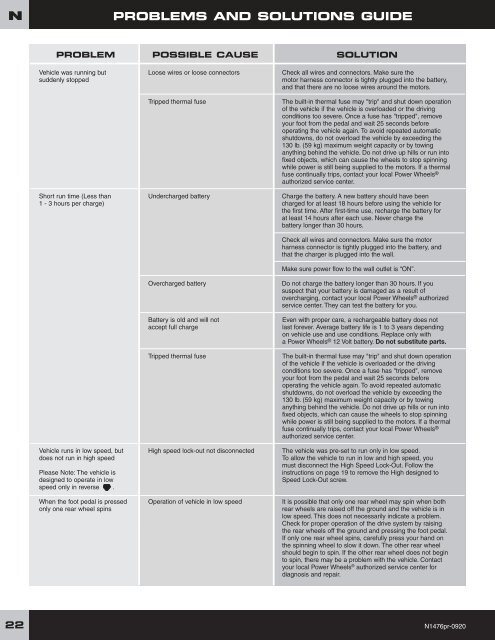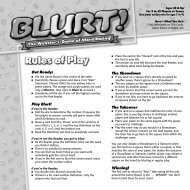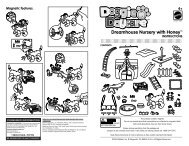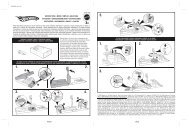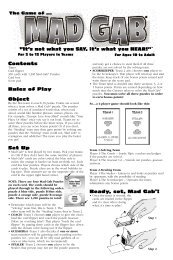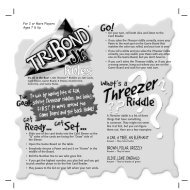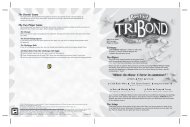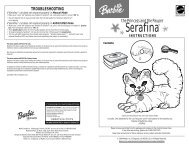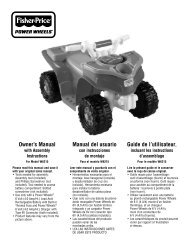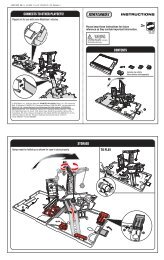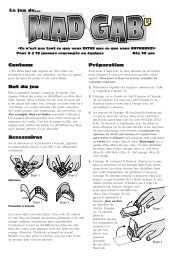Owner's Manual Owner's Manual
Owner's Manual Owner's Manual
Owner's Manual Owner's Manual
You also want an ePaper? Increase the reach of your titles
YUMPU automatically turns print PDFs into web optimized ePapers that Google loves.
N<br />
22<br />
PROBLEMS AND SOLUTIONS GUIDE<br />
PROBLEM POSSIBLE CAUSE SOLUTION<br />
Vehicle was running but Loose wires or loose connectors Check all wires and connectors. Make sure the<br />
suddenly stopped motor harness connector is tightly plugged into the battery,<br />
and that there are no loose wires around the motors.<br />
Tripped thermal fuse The built-in thermal fuse may "trip" and shut down operation<br />
of the vehicle if the vehicle is overloaded or the driving<br />
conditions too severe. Once a fuse has "tripped", remove<br />
your foot from the pedal and wait 25 seconds before<br />
operating the vehicle again. To avoid repeated automatic<br />
shutdowns, do not overload the vehicle by exceeding the<br />
130 lb. (59 kg) maximum weight capacity or by towing<br />
anything behind the vehicle. Do not drive up hills or run into<br />
fixed objects, which can cause the wheels to stop spinning<br />
while power is still being supplied to the motors. If a thermal<br />
fuse continually trips, contact your local Power Wheels ®<br />
authorized service center.<br />
Short run time (Less than Undercharged battery Charge the battery. A new battery should have been<br />
1 - 3 hours per charge) charged for at least 18 hours before using the vehicle for<br />
the first time. After first-time use, recharge the battery for<br />
at least 14 hours after each use. Never charge the<br />
battery longer than 30 hours.<br />
Check all wires and connectors. Make sure the motor<br />
harness connector is tightly plugged into the battery, and<br />
that the charger is plugged into the wall.<br />
Make sure power flow to the wall outlet is “ON”.<br />
Overcharged battery Do not charge the battery longer than 30 hours. If you<br />
suspect that your battery is damaged as a result of<br />
overcharging, contact your local Power Wheels ® authorized<br />
service center. They can test the battery for you.<br />
Battery is old and will not Even with proper care, a rechargeable battery does not<br />
accept full charge last forever. Average battery life is 1 to 3 years depending<br />
on vehicle use and use conditions. Replace only with<br />
a Power Wheels ® 12 Volt battery. Do not substitute parts.<br />
Tripped thermal fuse The built-in thermal fuse may "trip" and shut down operation<br />
of the vehicle if the vehicle is overloaded or the driving<br />
conditions too severe. Once a fuse has "tripped", remove<br />
your foot from the pedal and wait 25 seconds before<br />
operating the vehicle again. To avoid repeated automatic<br />
shutdowns, do not overload the vehicle by exceeding the<br />
130 lb. (59 kg) maximum weight capacity or by towing<br />
anything behind the vehicle. Do not drive up hills or run into<br />
fixed objects, which can cause the wheels to stop spinning<br />
while power is still being supplied to the motors. If a thermal<br />
fuse continually trips, contact your local Power Wheels ®<br />
authorized service center.<br />
Vehicle runs in low speed, but High speed lock-out not disconnected The vehicle was pre-set to run only in low speed.<br />
does not run in high speed To allow the vehicle to run in low and high speed, you<br />
must disconnect the High Speed Lock-Out. Follow the<br />
Please Note: The vehicle is instructions on page 19 to remove the High designed to<br />
designed to operate in low Speed Lock-Out screw.<br />
speed only in reverse .<br />
When the foot pedal is pressed Operation of vehicle in low speed It is possible that only one rear wheel may spin when both<br />
only one rear wheel spins rear wheels are raised off the ground and the vehicle is in<br />
low speed. This does not necessarily indicate a problem.<br />
Check for proper operation of the drive system by raising<br />
the rear wheels off the ground and pressing the foot pedal.<br />
If only one rear wheel spins, carefully press your hand on<br />
the spinning wheel to slow it down. The other rear wheel<br />
should begin to spin. If the other rear wheel does not begin<br />
to spin, there may be a problem with the vehicle. Contact<br />
your local Power Wheels ® authorized service center for<br />
diagnosis and repair.<br />
N1476pr-0920<br />
N1476pr-0920


